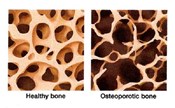Are You at Risk?
There are a variety of factors that can put you at risk for developing osteoporosis. These include both controllable and uncontrollable factors. It is important to discuss your risk factors with your healthcare provider. Together, you can develop a plan to protect your bones.
A woman’s risk of breaking a hip due to osteoporosis is equal to her risk of breast, ovarian and uterine cancer combined; a man age 50 or older is more likely to break a bone due to osteoporosis than he is to get prostate cancer.
Uncontrollable Risk Factors
- Being over age 50.
- Being Female.
- Menopause.
- Family History.
- Low Body Weight/Being Small and Thin.
- Broken Bones or Height Loss.
Controllable Risk Factors
- Not Getting Enough Calcium and Vitamin D.
- Not Eating Enough Fruits and Vegetables.
- Getting Too Much Protein, Sodium and Caffeine.
- Having an Inactive Lifestyle.
- Smoking.
- Drinking too much alcohol.
- Losing Weight.
There are also medications and diseases that can cause bone loss and increase your risk of osteoporosis.
Debunking the Myths
Myth #1: Most people don’t need to worry about osteoporosis.
Millions of Americans – 44 million to be exact – have low bone density or osteoporosis. In fact, about one in two women and up to one in four men over the age of 50 will break a bone due to osteoporosis. By 2020, half of all Americans over age 50 are expected to have low bone density or osteoporosis.
Myth #2: Osteoporosis is only a problem for older Caucasian women.
While osteoporosis is common among white women, men and women of all races can have the disease. Also, while the disease is more common in older people, it can strike at any age.
Myth #3: You don’t need to worry about osteoporosis if you break a bone from a serious fall or accident.
Broken bones in people over the age of 50 can be the first sign of low bone density or osteoporosis. Broken bones from serious falls or accidents are often related to osteoporosis.
Myth #4: People with osteoporosis can feel their bones getting weaker
Osteoporosis is commonly called a “silent disease.” Often, breaking a bone is the first clue you have osteoporosis. Some people learn that they have osteoporosis after they lose height from one or more broken bones in the spine. These broken bones can even occur without any noticeable pain.
Myth #5: An osteoporosis test is painful and exposes you to a lot of radiation.
Experts recommend a bone mineral density test using a central DXA (dual energy x-ray absorptiometry) machine. It is simple, painless, takes 5-10 minutes and uses very little radiation. You are exposed to 10-15 times more radiation from flying in a plane roundtrip between New York and San Francisco.
Myth #6: Children and teens do not need to worry about their bone health.
Children and teens can build strong bones and prevent osteoporosis by being physically active and getting enough calcium and vitamin D.
Myth #7: If you drink a lot of milk and exercise, you are not at risk for osteoporosis.
Even if you drink plenty of milk and exercise, you still may be at risk for osteoporosis.
Myth #8: Osteoporosis isn’t serious.
Broken bones from osteoporosis can be very painful and serious. Broken bones can affect physical, mental and emotional health, and in some cases, result in death. It is important to take steps throughout your life to protect your bones.
Myth #9: Taking extra calcium supplements can help prevent osteoporosis.
Taking more calcium than you need does not provide any extra benefits. Estimate the amount of calcium you get from foods on a typical day to determine whether a supplement is right for you. Find out how much calcium you need.
Myth #10: Most people do not need to take a vitamin D supplement.
Vitamin D helps your body use calcium. If you don’t get enough vitamin D, or if your body doesn’t absorb it well, you are at greater risk for osteoporosis. Your skin makes vitamin D when it is exposed to the sun and is also available in a few foods. However, many people need a vitamin D supplement. Find out how much vitamin D you need.
Source: National Osteoporosis Foundations, http://www.nof.org/







